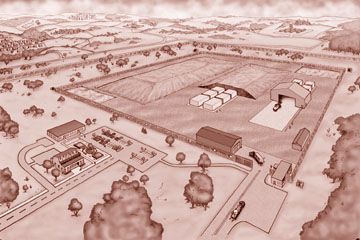What Have We Learned About
Disposing Of Low-Level Radioactive Waste?
Questions,
fears, concerns and disturbing anecdotes surface whenever the disposal of low-level
radioactive waste is discussed. Some are raised by residents in communities that are
looking into the facts and may be thinking of volunteering to host New Jersey's disposal
facility. Others are supplied by groups opposed to nuclear power. Whatever their source,
these concers should be reviewed and addressed by any community that might consider
hosting the disposal facility.
One concern
that is often cited is:
"They don't tell you that all the other
radwaste dumps leaked."
The implication is : This will happen here, in
your community, if you choose to host the disposal facility.
But: What about the early disposal facilities?
Did they fail? Why? And what have we learned from them?
What Were the Problems?
There were problems with the early commercial disposal facilities
at Maxey Flats, Kentucky; Sheffield, Illinois; and West Valley, New York. These were built
in the 1960's, before most of our current environmental laws and regulatory programs were
in place. All were closed in the 1970's. There were also problems caused by early
practices at the disposal facilities in Richland, Washington and Barnwell, South Carolina,
which have been corrected, and at Beatty, Nevada, which has since been closed to
radioactive waste.

Disposal technology no longer used. |
|
The major causes of the difficulties at these sites were that:  Sites were
inadequately analyzed and evaluated before the disposal facilities were constructed. Sites were
inadequately analyzed and evaluated before the disposal facilities were constructed.
 Much of
the waste was in liquid form. Much of
the waste was in liquid form.
 Much of
the waste was delivered in cardboard and fiberboard boxes, which disintegrated
quickly after burial. Much of
the waste was delivered in cardboard and fiberboard boxes, which disintegrated
quickly after burial.
 The
shallow-land burial trenches and covers did little to prevent the intrusion of surface and
groundwater into the waste packages. The
shallow-land burial trenches and covers did little to prevent the intrusion of surface and
groundwater into the waste packages.
This led to radionuclide migration. |
Because
of these problems, a great deal of attention has been focused on improving waste
form and packaging.
 Liquid waste
is not permitted.
Liquid waste
is not permitted.
 Shallow-land burial of the waste in trenches has been ruled out as an option in many
states, including New Jersey.
Shallow-land burial of the waste in trenches has been ruled out as an option in many
states, including New Jersey.
 The
Barnwell facility, which does use shallow-land burial, now requires that waste packages be
encased in concrete overpacks.
The
Barnwell facility, which does use shallow-land burial, now requires that waste packages be
encased in concrete overpacks.
 And
the design of new disposal sites now incorporates multiple, engineered layers of
protection to keep water away from the waste.
And
the design of new disposal sites now incorporates multiple, engineered layers of
protection to keep water away from the waste.
It should also be noted that even at the closed sites, remedial measures have been
taken to avoid any radiation exposure to the public. No health hazards or any
environmental effects have been observed, nor are there expected to be any. None
of the stringent state or federal health and safety standards for off-site radiation
exposure have been exceeded at any time at any of these sites.
What Have We Learned?
We have learned that even though these
facilities had problems, they have caused no harm to human health or to the environment.
We have learned that these facilities don't
become highly dangerous even when they do develop problems. Their problems can be
addressed, monitored and mitigated.
We have learned that careful attention to the
form of the waste increases the level of protection.
Any liquid waste must be converted to a solid
prior to disposal.
Waste in solid form only will be accepted at a
disposal facility.
Waste must be packaged in strong containers that
meet strict federal guidelines.
We have learned that, before selecting a site
for a disposal facility, geological and hydrological characteristics must be rigorously
studied and evaluated to determine if the natural barriers will work in concert with the
manmade structures of the disposal facility to safely contain the waste.
We have learned that monitoring the air, water
and living organisms on and near the disposal site to detect any migration of radioactive
materials can be effectively accomplished, and that problems can be remediated long before
they threaten human health and the environment.
 |
All low-level
radioactive waste, including waste from nuclear power reactors, poses a health risk if
not properly managed. Lessons learned during the early years of commercial low-level
radioactive waste disposal led to regulatory reform of the system under which disposal is
conducted. The improvements in waste form, as well as stringent requirements for site
selection, operations, monitoring, and care after operations have ceased, will eliminate
the primary causes of the leaks seen in the early disposal facilities, and will
effectively isolate the waste from the people and the environment. |
Return to Public Information Material Home Page
 Back to the Siting Board Home Page
Back to the Siting Board Home Page
Last updated April 1998

![]() Sites were
inadequately analyzed and evaluated before the disposal facilities were constructed.
Sites were
inadequately analyzed and evaluated before the disposal facilities were constructed.![]() Much of
the waste was in liquid form.
Much of
the waste was in liquid form.![]() Much of
the waste was delivered in cardboard and fiberboard boxes, which disintegrated
quickly after burial.
Much of
the waste was delivered in cardboard and fiberboard boxes, which disintegrated
quickly after burial.![]() The
shallow-land burial trenches and covers did little to prevent the intrusion of surface and
groundwater into the waste packages.
The
shallow-land burial trenches and covers did little to prevent the intrusion of surface and
groundwater into the waste packages.